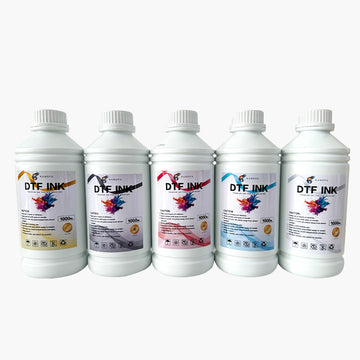TL;DR
DTF ink quality defines your print brightness, color stability, and wash durability.
Learn the differences between CMYK + White DTF inks, how to match them with your film and powder, and key tips to avoid clogging or fading.

💧 1) What Is DTF Ink?
DTF ink is a specially formulated pigment-based ink designed to print directly onto PET film before heat transfer.
It’s made to bond with TPU hot-melt powder, creating a flexible and vibrant layer that fuses into fabrics under heat.
Unlike sublimation ink, DTF ink prints on both dark and light fabrics, including cotton, polyester, canvas, and blends — making it far more versatile for commercial applications.
🌈 2) The DTF Ink Set: CMYK + White
| Ink | Function | Notes |
|---|---|---|
| Cyan, Magenta, Yellow, Black (CMYK) | Color layer | Determines tone, gradient, and vividness |
| White Ink | Underbase | Increases contrast, opacity, and color accuracy on dark fabrics |
Why it matters:
White ink acts like a primer—without it, colors on black or colored garments look faded or transparent.
⚖️ 3) DTF Ink vs. DTG & Sublimation Inks
| Feature | DTF Ink | DTG Ink | Sublimation Ink |
|---|---|---|---|
| Base Type | Pigment | Pigment | Dye |
| Fabric Compatibility | Cotton, polyester, blends, leather | Cotton | Polyester (only) |
| Durability | ⭐⭐⭐⭐ | ⭐⭐⭐ | ⭐⭐⭐⭐ |
| Color Range | CMYK + White | CMYK + White | CMYK |
| Workflow | Film transfer | Direct garment print | Heat transfer on coated surfaces |
👉 Takeaway:
DTF inks combine the color flexibility of DTG with the material range of sublimation, offering the best of both worlds.
🔬 4) Choosing the Right Ink for Your Printer
When selecting DTF inks, always consider:
-
Printer compatibility: Epson-based or industrial head (i3200 / XP600 / 4720 / StarFire).
-
Viscosity & fluidity: Match your printer’s temperature and pump rate.
-
Color accuracy: ICC profiles or RIP presets should match your ink brand.
-
Batch consistency: Look for factory-sealed packaging with batch codes.
Pro Tip:
If your printer supports white ink recirculation, always enable it — it prevents pigment settling and nozzle clogs.
💡 5) How to Keep DTF Inks Performing at Their Best
-
Agitate white ink daily (manual or auto recirculation).
-
Clean capping stations & dampers weekly.
-
Keep room temperature 20–26°C (68–79°F) and humidity 45–60% RH.
-
Use genuine RIP settings for your ink brand to prevent over-saturation or color drift.
-
Never mix ink brands in the same channel — even if colors look similar.
🧪 6) Quick Troubleshooting
| Symptom | Cause | Fix |
|---|---|---|
| White ink clogging | Pigment settling | Agitate ink; enable recirculation |
| Colors look dull | Incorrect ICC or low ink density | Update RIP profile; raise density 5–10% |
| Print not bonding | Ink undercured / bad powder | Check dryer temp (110–130°C); replace powder |
| Edge bleeding | Too much ink or humidity | Lower ink limit; stabilize humidity |
| Cracks after washing | Overcured or low-quality ink | Lower heat; use premium-grade TPU ink |
🧱 7) Business Impact: Why Ink Quality = Profit
-
Consistent colors = fewer reprints.
-
Stable flow = fewer maintenance stops.
-
Longer nozzle life = lower cost per print.
-
Better wash performance = happier customers and repeat orders.
When you find the right ink brand that matches your printer and film, it becomes the core of your reliability — your customers will notice.
🏆 Why Choose KungFuDTF Inks
At KungFuDTF, our inks are:
-
🧪 Formulated for Epson and i3200 printheads
-
🎨 High-opacity white, anti-settling with smooth recirculation
-
💧 CMYK pigments engineered for color accuracy and strong adhesion
-
🔥 Quick-drying, compatible with all major DTF films and powders
We test every batch with 72-hour continuous printing to guarantee no clogging, consistent density, and vivid color.
👉 Contact us for sample liters or OEM partnerships.






